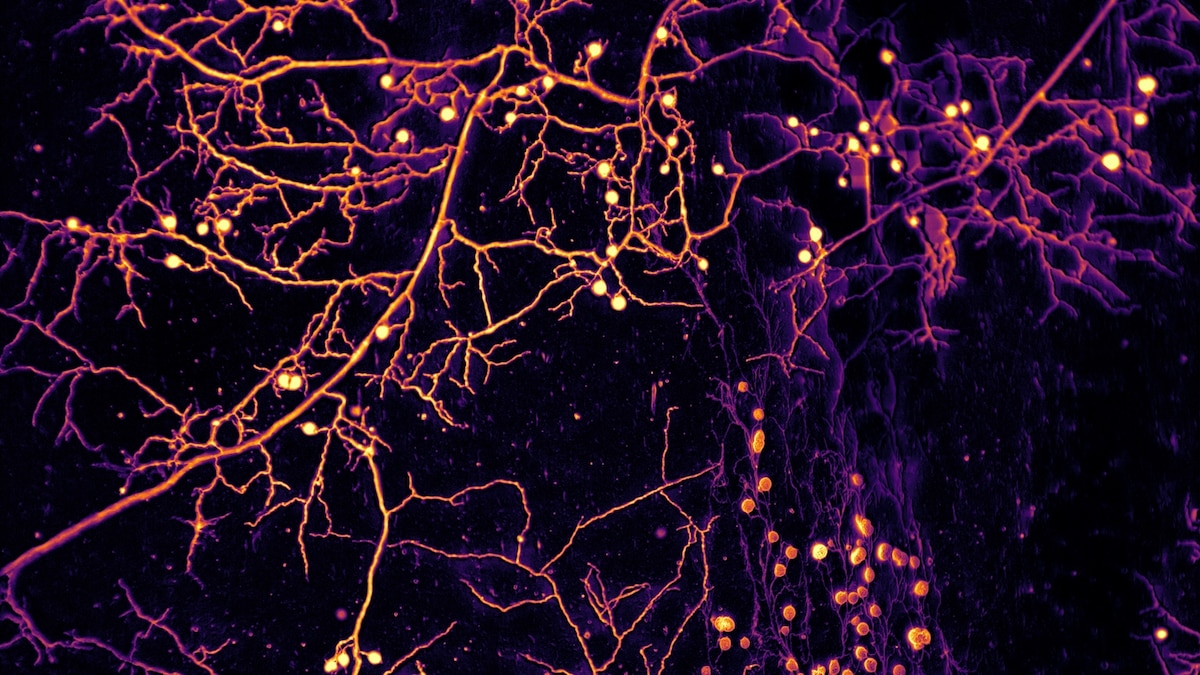Now Reading: These are the real fungal ‘superhighways’ that inspired ‘The Last of Us’
-
01
These are the real fungal ‘superhighways’ that inspired ‘The Last of Us’
These are the real fungal ‘superhighways’ that inspired ‘The Last of Us’

In HBO’s apocalyptic series The Last of Us, protagonist Ellie Williams stands on a balcony, overlooking a ruined Boston street. A mass of human bodies—infected by a human-specific variant of the Cordyceps fungus—lies below. As sunlight hits a few of the bodies, they begin to writhe. Others, still in shadow, begin to move too. “They’re connected,” Ellie says. “More than you know,” one of her companions ominously replies.
This scene from the show’s first season reveals that the infected are linked by long fungal tendrils that can stretch for miles underground—what biologists call a mycelial network. Later in the same episode, another character shoots one infected and watches as fungal tendrils wrap around its hand. The tendrils appear to send a message underground, summoning a horde of other infected to a potential feast.
The real fungal genus Ophiocordyceps limits its networks to the host insects that it infects and turns into zombies, controlling where they walk and how they behave. But many other fungi form mycelial networks under the soil without nefarious intentions. Some of these species form partnerships called mycorrhizal symbioses with plant roots. How these fungi grow their networks to find new resources and plant partners, however, isn’t clear.
A new study, published February 26 in Nature, reveals that these mycelial networks venture forth in waves, creating loops and even fungal superhighways to transport nutrients back and forth. The scientists have even captured what this transport looks like in images and videos where you can see carbon molecules being shuttled back and forth. Far from the zombie “hive mind” of science fiction, these networks are potentially global supply chains, and masterclasses in networking.
(Learn more about the fungus featured in ‘The Last of Us’.)
Fungus among us
When a fungus forms a partnership with a plant, they get close. Very, very close. Somewhat like the fungal filaments that can stab human victims in The Last of Us, real structures called hyphae actually push in to the root cell of the plant. “When they penetrate into the cell, they make this beautiful structure called an arbuscule that looks like a mini tree,” explains Toby Kiers, an evolutionary biologist at Vrije Universiteit, Amsterdam in the Netherlands and executive director of SPUN, the Society for the Protection of Underground Networks.
Unlike The Last of Us, this partnership offers mutual benefit instead of horror-esque parasitism. The fungi send microscopic filaments into the soil, sourcing hard-to-find resources such as phosphorus that the plant needs to grow. The plant, in turn, offers carbon-rich food in the form of fats and sugars.
The collaboration is nearly 450 million years old, and so popular that 70 percent of land plant species have a partner fungus in their roots. But nutrients in an area can run out. Plant partners can die. The fungi have to keep growing their network. “The fungi are really growing out and exploring for resources, and they’re also exploring for new partners,” Kiers says. “What we wanted to do was to be able to actually see how they build the networks in real time.”
The challenge is that all of this networking is taking place underground. Many studies of these fungi happen in little pots, explains Carlos Aguilar-Trigueros, a fungal ecologist at the University of Jyväskylä in Finland who was not involved in the study. “It’s cheap, and it’s effective, because you just need a greenhouse, a pot, and you just hope for the best that the fungi will grow,” he says.
But scientists can only see a fully formed fungal network in a potted plant experiment. Luckily, a few of these strains can grow in divided petri dishes, with a tiny carrot root intertwined with fungal filaments on one half, and the questing fungal network on the other.
The setup allows Kiers and her colleagues to observe 40 dishes filled with networks for around two to six months as they grow, photographing them every two hours under a microscope. Capturing and analyzing that many images is a daunting task, though. “If we were to sit in front of the microscope,” Kiers says, “we calculated that it would have taken us about a century to collect this much data.”
(See how other science fiction TV shows and movies stack up against real science.)
You May Also Like
Enter the robot
Kiers and her colleagues designed an imaging robot that could take the pictures and help analyze them, identifying about 500,000 nodes where fungi were forging new paths. The robot—the size of a person with a single long mechanical arm—pulls plates out one by one, photographing them under its microscope and sliding them back into their allotted places. With the machine’s help, the scientists showed that fungal networks grow outward like a wave, with expanding tips pulling the nutrient absorbing parts of the fungus after them. It’s not a simple move. Instead the fungus builds an entire supply chain behind it.

Fungi can enhance the volume of nutrients that pass through their networks both by widening hyphal tubes and driving faster flows along “trunk routes” of the network.
Photograph By Loreto Oyarte Galvez, VU Amsterdam, AMOLF
Other organisms that grow films or networks like bacteria or slime molds would just fill the area until all the nutrients are gone. Not these. “These fungi are traders,” Kiers says. “Should I go explore for new routes and see who’s out there, or should I really concentrate on getting those resources and sending them back to the root.” Sucking up nutrients means draining an area in the long run, but exploring too much means the fungus could run out of energy. The balance, the scientists showed, means the network branches out, but doesn’t truly fill in the gaps, creating a lacework of underground fungi.
As the network finds new resources and plant partners, it also makes itself more efficient. Some parts grow together into loops, allowing supplies to travel more quickly. When the plant has a need for fast transport, or distances are long, the fungi widen their little hyphal tubes into superhighways for nutrients—highways where nutrients can even flow backward and forward in two directions at once.
Sometimes “you’ll see flow just in one direction,” says Howard Stone, an engineer at Princeton University in New Jersey. “But the system is always changing, and different parts of the system are somehow communicating through the network, but they’re doing things in a certain sense, independently.” Flow in both directions in a single tube is very rare in nature. Scientists also aren’t sure how the fungi make the flows happen, but they do appear to be able to regulate them on the fly.
(Could a parasitic fungus really evolve to control humans?)
‘The Earth’s circulatory system’
The robot and its ability to show how networks grow is a breakthrough for fungal research, Aguilar-Trigueros says. “The fact that they figured out a method to map those networks, I think it’s going [to] open a whole new window of things that one can measure to understand how these symbioses work.”
This underground fungal network, Keirs says, is like “Earth’s circulatory system,” transporting nutrients from plant to soil, and from soil back to plant. And while the networks in the study are tiny, in the ground, they pull down massive amounts of carbon from the atmosphere. Underground fungi acquire about 13 billion tons of carbon dioxide from plants every year.
The paper offers a powerful description of how fungi grow and spread out, says Paola Bonfante, a plant biologist at the University of Turin in Italy who was not involved in the study. But tiny petri dishes, she notes, are not forests, with many species of plants and fungi, all working in different ways. The paper, she notes, “has given us some clear points to start,” to understand much larger natural networks.
It’s unclear how connected individual fungal networks are across ecosystems—or even globally. Keirs is now hoping to map these networks in soil around the world, “to understand how big they are, where they’re processing all of this carbon, where the carbon draw-down hot spots [are], and what the diversity of these communities look like, from deserts to forests.”
The possibility of a global fungal network might sound ominous. But unlike humans in The Last of Us, no plant fears becoming infected. In fact, they welcome the fungi. The fungi do the networking, building their supply chains, and plants, and the world, benefit.























